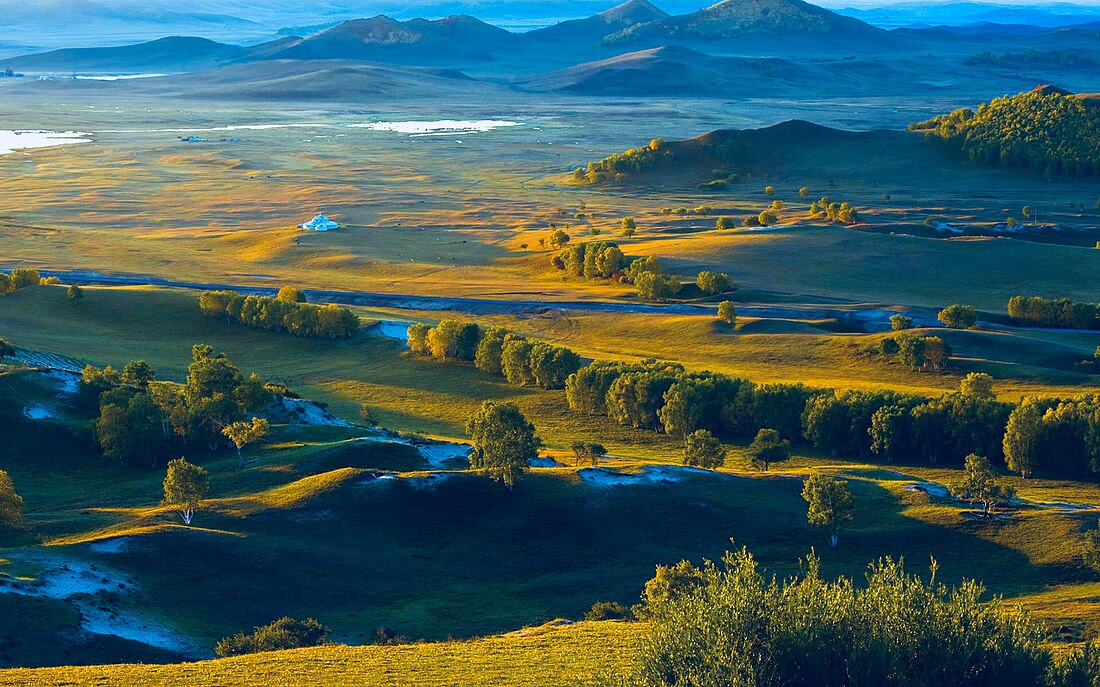Top Qs
Timeline
Chat
Perspective
Fengning Manchu Autonomous County
Autonomous county in Hebei, China From Wikipedia, the free encyclopedia
Remove ads
Fengning Manchu Autonomous County (Chinese: 丰宁满族自治县; Manchu: ᡶᡝᠩ ᠨᡳᠩ ᠮᠠᠨᠵᡠ ᡠᡴᠰᡠᡵᠠ ᠪᡝᠶᡝ ᡰᡥᡳ ᠰᡳᠶᠠᠨ) is a Manchu autonomous county of northern Hebei province, bordering Beijing to the southwest and Inner Mongolia to the north, and lying under the administration of the prefecture-level city of Chengde.
It is the second-largest county of Hebei in terms of area, after the neighbouring Weichang Manchu and Mongol Autonomous County.
Remove ads
History
Fossils from the Jinfengopteryx, a genus of dinosaur, were discovered in Fengning Manchu Autonomous County.[2] Other dinosaur fossils discovered in the autonomous county include one belonging to the ceratopsia suborder, and one of a stegosaurus,[2] which both date back to approximately 130,000 million years ago.[3] The area belonged to the wider Jehol Biota ecosystem.[2]
Evidence suggests of human activity in the area of present-day Fengning Manchu Autonomous County dates back to approximately 30,000 to 50,000 years ago.[2] Archaeological sites from the Hongshan culture and the Shanrong have been found in the autonomous county.[2]
Qing dynasty
In 1735, the 13th year of the Yongzheng Emperor's, the Siqi Subprefecture (simplified Chinese: 四旗厅; traditional Chinese: 四旗廳; pinyin: Sìqí Tīng) was established in the area.[2] In 1778, the area was reorganized as Fengning County (simplified Chinese: 丰宁县; traditional Chinese: 豐寧縣; pinyin: Fēngníng Xiàn).[2]
People's Republic of China
In 1987, the State Council approve re-designating Fengning County as Fengning Manchu Autonomous County.[2]
Remove ads
Geography
Summarize
Perspective
Fengning Manchu Autonomous County is bordered by Beijing to the south and Inner Mongolia to the north.[2] The autonomous county is located at the northern edge of the Yan Mountains, and the southern edge of the Inner Mongolia Plateau.[2]
The Chao River, a tributary of the Chaobai River, and the Luan River both originate within the autonomous county.[2]
The autonomous county is covered by 8.81 million mu of forest, 58.53% of its total area.[2]
Geology
Fossil-bearing rocks of the Mesozoic Huajiying Formation and/or Yixian Formation occur on the surface. The prehistoric bird Paraprotopteryx was found in such a deposit.
Climate
Fengning has a rather dry, monsoon-influenced humid continental climate (Köppen Dwa), with long, very cold and dry winters, and hot, humid summers, and the elevation depresses temperatures. The monthly 24-hour mean temperature in January is −10.6 °C (12.9 °F), and in July it is 22.6 °C (72.7 °F), while the annual mean is 7.2 °C (45.0 °F). More than half of the annual precipitation occurs in July and August alone.
Remove ads
Administrative divisions
The county has 1 subdistrict, 11 towns and 15 townships under its administration.[7] These township-level divisions then, in turn, administer 309 village-level divisions.[2]
|
Subdistrict:
Towns:
|
Townships:
|
Demographics
Per government sources, Fengning Manchu Autonomous County has an urbanization rate of 24.35%.[2]
Ethnic groups
There are 35 different government-recognized ethnic groups living in Fengning Manchu Autonomous County.[2] Approximately 266,400 residents are ethnically Manchu (66.56% of the total population).[2] The next largest ethnic group are the Han Chinese, which number about 106,800 (26.69%).[2] Other major ethnic groups in the autonomous county include the Hui and the Mongols.[2]
Remove ads
Economy

The county draws in many tourists as the Bashang Grasslands in the far north of the county is the nearest grasslands to Beijing.[8] The cultivation of a local tourism is part of a broader regional development policy to support tourism as a primary industry in the Chengde area due to the environmentally friendly character of the industry going well with the goal of preserving the Chengde area's pristine environment, especially compared to the pollution problems besetting the rest of Hebei and also Beijing and Tianjin.[8]
The county's primary tourist attraction are the horse ranches in the Datan grassland. Other highlights are the Dahan Palace of Genghis Khan and the Baiyun Ancient Cave.[8] The height of the tourism season is in July and August when there are bonfire festivities filled with ethnic songs and dances, roasted whole lamb, and staged traditional sporting events like wrestling and archery.[8]
Significant deposits of molybdenum have been found in Fengning Manchu Autonomous County.[2]
Remove ads
Culture
The Manchu people of Fengning Manchu Autonomous County have a distinct style of papercutting, which is included in China's National Intangible Cultural Heritage List.[2]
Transport
Both China National Highway 111 and 112 pass through the county, with the former providing direct access to Beijing. The Zhangjiakou–Chengde Expressway, a segment of the G95 Capital Area Loop Expressway, also runs through the autonomous county.[2]
The autonomous county is served by two railroads: the Duolun–Fengning railway, which runs from Fengning Manchu Autonomous County to Duolun County in Inner Mongolia, and the Tangshan–Baotou railway.[2]
Remove ads
Notable people
References
External links
Wikiwand - on
Seamless Wikipedia browsing. On steroids.
Remove ads


